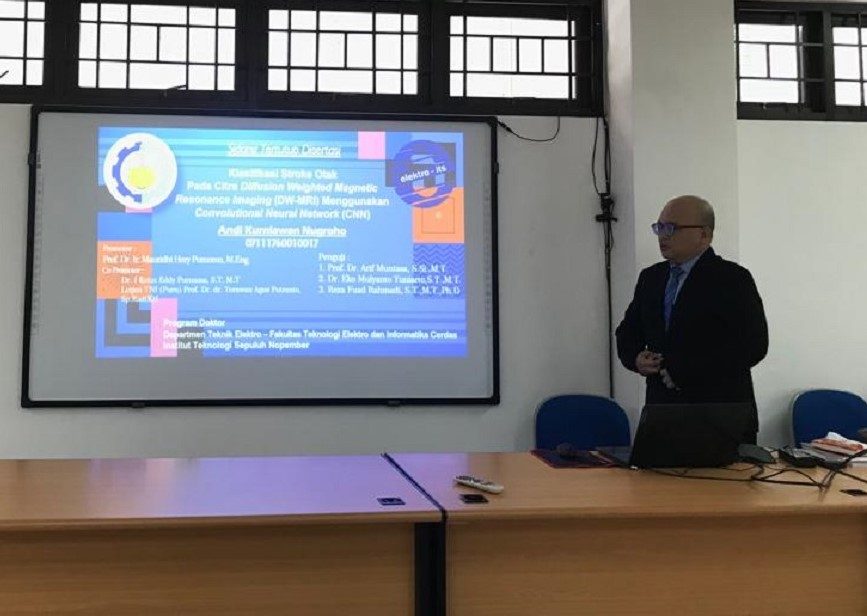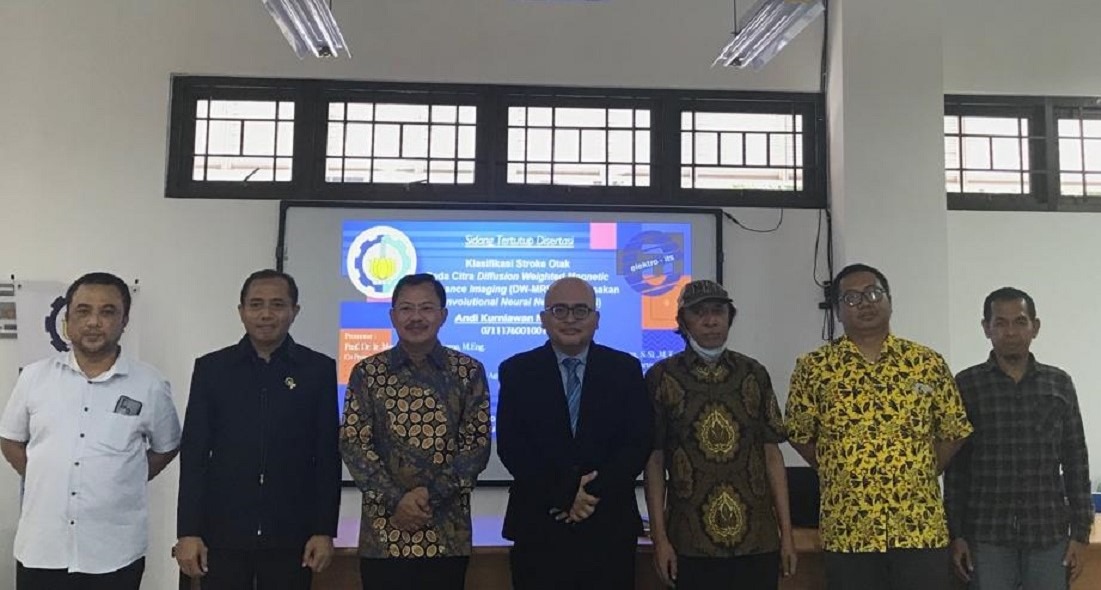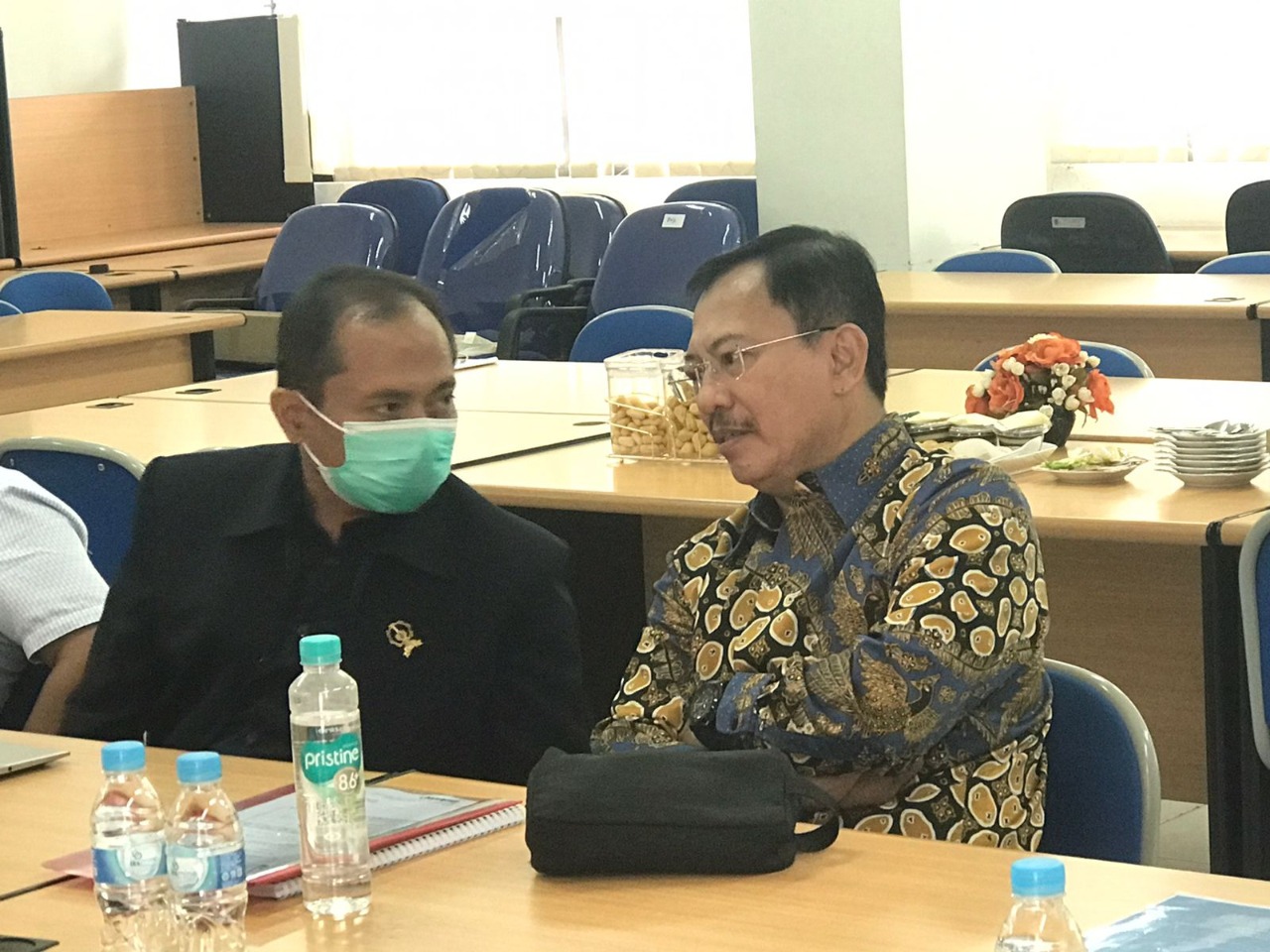ITS Doctor Creates Automatic Stroke Diagnosis System

Dr. Andi Kurniawan Nugroho ST MT presented his dissertation at the Closed Session of the ITS Electrical Engineering Doctoral Promotion.
ITS Campus, ITS News – Current stroke management methods, such as CT Scan and Magnetic Resonance Imaging (MRI), require a reasonably long diagnosis time and interpretation results depend on the subjective assessment of the radiologist. Facing these challenges, one of the doctors from Institut Teknologi Sepuluh Nopember (ITS), Dr. Andi Kurniawan Nugroho ST MT, innovated an automatic stroke diagnosis system based on image processing. Hence, the process is faster with accurate results.
Stroke is a disease with high mortality and morbidity rates, so severe treatment is needed for sufferers. The treatment of stroke patients is very dependent on the results of the diagnosis by the doctor concerned, the faster and more accurate the results of the diagnosis, the better the treatment that can be given to the patient. “With the right diagnosis, treatment will be faster, therapy and dosage are more precise, and treatment costs are smaller,” said Andi.
Continued Andi, stroke is classified into two types: ischemic and hemorrhagic. Ischemic stroke is a type of stroke caused by a blockage in the brain. This blockage can cause a rupture of one of the arteries in the brain, causing bleeding and leading to a hemorrhagic stroke. “These different types of stroke require different treatment,” explained the man born in Batam.

Dr. Andi Kurniawan Nugroho ST MT (fourth from left) with his supervisor and dissertation examiner team after a closed session of doctoral promotion at the Department of Electrical Engineering ITS
In his dissertation entitled Classification of Brain Strokes in Diffusion-Weighted Magnetic Resonance Imaging (DW-MRI) Images Using Convolutional Neural Network (CNN), Andi created a system design capable of classifying stroke types with an accuracy of up to 97 percent.
“Based on image processing, this system can distinguish the types of ischemic stroke and hemorrhagic stroke with a shorter duration,” said the ITS doctor who had completed the Closed Session of Doctoral Promotion for the Doctoral Program of the ITS Electrical Engineering Department on August 2 last.
Not only that, but Andi added that this system could also classify the level of ischemic stroke into three classes, namely acute, subacute, and chronic stages. “This level is very influential on administering drug doses to patients later,” he said.

Former Indonesian Minister of Health Lt. Gen. TNI (Ret.) Prof. Dr. dr. Terawan Agus Putranto Sp Rad(K)I (right) as one of the dissertation supervisors who attended the trial
Furthermore, this dissertation received direct guidance from the former Indonesian Minister of Health, Lt. Gen. TNI (Ret.) Prof. Dr. dr. Terawan Agus Putranto Sp Rad(K) I, is also supported by valid data. All research data is primary data obtained directly from a hospital in Indonesia that handles stroke patients. “The ethics committee has approved all the data obtained, and the patient’s identity is kept confidential,” he said.
Finally, the man who currently works as a lecturer at the Department of Electrical Engineering at the University of Semarang (USM) hopes that the modeling system can be further developed and implemented in the world of Health. “Hopefully, this research can be useful for the wider community and contribute to improving the quality of treatment in Indonesia,” he concluded. (ITS Public Relations)
Reporter: Frecia Elrivia Mardianto
Related News
-
ITS Collaboration with BPBD East Java, Launching VR Disaster Simulation
ITS Campus, ITS News — Supporting anticipation of disasters and continuing to educate the public, Institut Teknologi Sepuluh Nopember
August 25, 2022 00:08 -
Supporting the Implementation of Innovative Ideas, ITS and IYSA Hold International Competition
ITS Campus, ITS News — Institut Teknologi Sepuluh Nopember (ITS) has once again proven its commitment to supporting the
August 25, 2022 00:08 -
ITS Maintains Informative Qualification for Five Consecutive Years at KIP Awards
ITS Campus, ITS News — Institut Teknologi Sepuluh Nopember (ITS) has once again successfully maintained its Informative Qualification predicate
August 25, 2022 00:08 -
ITS Strengthens Smart Eco-Campus through UI GreenMetric 2024
ITS Campus, ITS News — Institut Teknologi Sepuluh Nopember (ITS) has once again demonstrated its commitment to environmental concern
August 25, 2022 00:08
